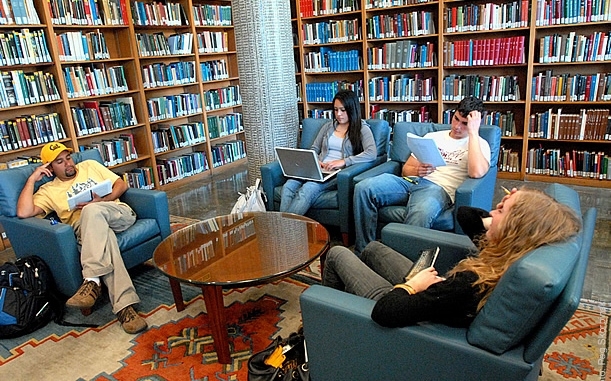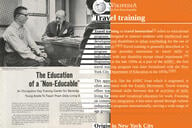You have /5 articles left.
Sign up for a free account or log in.

Students read at the University of California at Berkeley's George and Mary Foster Anthropology Library.
University of California at Berkeley
Close lots of library locations on campus, or close fewer and see services reduced at most of the remaining locations. Faced with those options in light of a budget crunch, the faculty at the University of California at Berkeley aid no to both and set out to find alternative funding sources to save the library -- all 25 locations. While the university's main library complex, referred to as Doe/Moffitt, was never in danger, professors wanted to preserve the smaller reading spaces housing specialized collections -- and the librarians who know them intimately.
Their plan, recently announced in partnership with the administration, calls for discretionary fund transfers from elsewhere in the university budget and contributions from individual faculty members’ research money, starting next year. It’s not a perfect fix – the library will still have to streamline services and questions remain as to how much faculty will contribute – but librarians and professors at the major research institution are calling it a win.
“It was gratifying, of course, to have the campus say we’re going to do the best we can, and be very specific about where they’re going to get the money,” said Lynn Jones, a reference and instruction librarian at Berkeley and chair of its Librarians’ Association of the University of California chapter. “We’re a major research library, not a college research library. People expect us to have whatever they need, and that’s important for the retention of faculty.”
Under the plan, the chancellor will give the library $3 million annually from his discretionary funds. Another $1.6 million will come from indirect research cost recovery, by making those who hold endowed chairs with annual payouts of $10,000 or more ineligible for some of those funds. Deans are responsible for finding another $1 million in their budgets, and faculty are slated for up to $500,000 in voluntary contributions from their individual research dollars.
The library is responsible for drawing about $1 million annually from its reserves and shaving another $1 million off its budget by streamlining services.
A new fund-raising campaign for the library also has been established, with the goal of collecting several million dollars annually.
“Securing the full $8.1 [million per year] can only be accomplished through the concerted effort of central administration, the deans and departments, and the faculty working together for the common good,” reads the plan, written by Elizabeth Deakin, professor of city and regional planning and urban design and president of Berkeley’s Academic Senate, and Provost George Breslauer. “We believe [it] will assure that our library remains the jewel it has always been, for students and our faculty and for the broader public.”
Deakin and Breslauer drafted the plan in response to earlier report on the future of the library. That report said the library would become “more, rather than less, critical to university research and teaching in the next 20 years” and recommended a one-time $5 million infusion of cash into the university budget to make up for past shortfalls and an additional, $6.5 million increase to the library’s annual budget, to remain competitive among peer institutions. The University of Michigan, for example, has managed to increase its library budget by 4 percent annually, and has dozens more full-time librarians than Berkeley.
Both efforts followed an earlier proposal from the library on how to best handle the 20 additional, full-time staff members it would have to lose through attrition spanning three years, to meet budget goals. While collections could be consolidated and were therefore never in danger, the library said it could not "soldier along" in terms of services with so few personnel. In a survey of students and faculty, it proposed two, preliminary models for its future as part of its "Re-envisioning" initiative. The first, called the "full-service libraries" model, called for the consolidation of Berkeley's 25 libraries into nine large libraries with each offering long hours, a full range of services and large collections integrating similar disciplines. The second, "hub-and-cluster" library model called for 15 libraries total, with six large libraries offering a full range of services and nine, additional libraries offering limited, circulation-only services.
Faculty rejected both ideas and drafted a petition saying there are “no first-rate universities in the world without a first-rate library.” Berkeley formed a commission of librarians and outside experts, such as the director of research for Google, to study the matter in 2012.
"People were so unhappy with the choices they were being offered," Deakin said of the proposed models. Now, she said, the library budget problem hasn't been wholly resolved, but professors are "very optimistic that our library will continue to serve as one of the world's great research and teaching resources."
In an email, Tom Leonard, university librarian, call the effort an example of Berkeley’s commitment to shared governance, including undergraduate students. They met with faculty members and administrators to discuss their library needs, he said.
But Jones said the faculty was essential in reviving the library budget. Professors are “the top of the food chain here on campus. If faculty work together to make noise, you can really achieve things.”
She praised the university’s decision to establish the Campaign for the Berkeley Library in particular, as libraries – outside of academic departments – lack a “natural constituency” for donations, even though they’re a “common good.”
Berkeley, like other California public institutions, has suffered from state budget cuts since the recession, and the library has taken some of the biggest blows. It’s lost 21, or about 25 percent, of its career librarians through attrition since 2003 – 19 since 2009 alone. It’s lost even more support staff. That means far fewer available librarians to teach on-site research classes and to help students and professors locate the materials they need to work.
But budgets cuts also have threatened the library’s ability to maintain resources – mostly the more than 90,000 journal subscriptions faculty and students report using, with some costing $25,000 annually, Jones said. “It’s hard when a faculty member says to you, ‘I need you to buy this journal,’ and you say, ‘What would you like me to cancel so we can buy that?’” (Library expenditures on serials have increased more than 400 percent since the late 1980s, compared to a 188 percent increase for library expenditures over all.)
Facilities also are hurting. “We’ve got a building that’s 45 years old and has never been remodeled – it’s embarrassing,” Jones said of the large Moffitt Undergraduate Library.
The new funding plan increases the current library budget, to address some of these issues, and to offer extended library hours.
Deakin said she had “no idea” whether faculty would come through with the $500,000 voluntary contribution, but said that they’re engaged in the plan either way, given that the $1.6 million chunk of the funding plan comes from money professors bring in by winning grants and contracts.





